Pakistan’s high inflation pushing up house prices
Pakistan’s high inflation makes it appear that house prices are rising strongly. But it’s an illusion. Nationwide house prices, in nominal terms, rose by 5.05% to PKR 10,875 (US$ 77) per square feet (sq. ft) during the year to Q1 2019, according to Pakistan’s largest property portal zameen.com. However when adjusted for inflation, house prices actually dropped 3.98% over the same period.
Quarter-on-quarter, nationwide house prices rose by a meager 0.95% in Q1 2019 (fell by 2.07% when adjusted for inflation).
In March 2019, Pakistan’s inflation stood at 9.4%, up from 8.2% in the previous month and 3.2% in the same period last year, according to the Pakistan Bureau of Statistics (PBS). In fact, it was the highest level recorded since November 2013.
In Pakistan’s major cities:
- In Lahore, the average house price was PKR 10,402 (US$ 73) per sq. ft in Q1 2019, up 6.25% from a year earlier, but actually down 2.89% when adjusted for inflation.
- In Karachi, house prices averaged PKR 13,158 (US$ 93) per sq. ft in Q1 2019, up 4.25% from the previous year, but down 4.62% when adjusted for inflation.
- In Islamabad, house prices averaged PKR 9,985 (US$ 70) per sq. ft in Q1 2019, up by 7.01% from a year earlier, but down 2.2% in real terms.
The Pakistani rupee (PKR) lost about 25% of its value against the US dollar in just two years, from PKR 104.804 =US$1 in March 2017 to PKR 139.177 = US$1 in March 2019. The State Bank of Pakistan (SBP), the country’s central bank, devalued its currency several times last year, as the government negotiates a bailout with the International Monetary Fund (IMF) to address its ballooning current account and fiscal deficits that threaten to trigger a balance of payments crisis.
So from a US$-based investor’s perspective, Pakistan’s housing has become cheaper when the recent devaluations of the rupee are taken into consideration.
Despite the country´s troubles, the economy grew by a robust 5.2% in 2018, after expanding by 5.4% in 2017, 4.6% in 2016, and 4.1% in both 2014 and 2015, according to the SBP. Economic growth is projected to slow to around 3.9% during the FY2019, according to the Asian Development Bank (ADB).
Foreigners working and living in Pakistan can buy or rent properties. However, the government requires them to complete certain legal formalities with the Board of Investment and the Trade Development Authority of Pakistan.
New government brings new hope
Investor confidence in Pakistan has dramatically improved since the Pakistan Tehreek-Insaf (PTI) party, led by Prime Minister Imran Khan, came into power last August 2018. Khan’s predecessor, former PM Nawaz Sharif, was forced to resign after being disqualified over corruption charges. Khan pledged to end corruption and dynastic politics, and introduce economic reforms.
“The government is coming up with some regulations; plus security and safety is improving, so prices are going up as a result. Hence, it’s the right time to invest in Pakistan and the returns are very good ” said Ahmed Shaikhani of Shaikhani Group.
This positive view was shared by Zeeshan Ali Khan, CEO and co-founder of zameen.com. “After the new government took over, we are seeing the property market is getting active again,” said Khan. “People are looking at investing again. There is a sense of confidence on the ground and if that keeps building, we will start seeing an increase in prices.”

“While the overall picture remains optimistic after the elections, market participants are still waiting on the direction of economic policies by the new government and which will set the tone for 2019 and beyond,” said Sameer Lakhani of Global Capital Partners. “Should the government provide impetus for the affordable housing push - backed by mortgage reform and the offering of such products by the banking sector — property values can then enter a period of sustained growth.”
Imran Khan´s troubled inheritance
Despite renewed optimism, Pakistan´s new Prime Minister has come to power in a country with enormous problems:
- Very poor security situation
- Large and only semi-controllable military
- Large refugee problem, conflict with Afghanistan´s Taliban
- Semi-independent regional political establishments
- Worryingly large block of extremist religious opinion
- Ongoing dispute with India over Kashmir
- Poor infrastructure, historic pattern of under-investment
It would be foolhardy to forecast success for Khan. He is an extraordinary figure - English-educated, a star cricketer, a successful ex-chancellor of a UK University (Bradford University), an ex-playboy who in an about-turn became a devout Muslim, a man of peace who has taken the stance of demanding a Pakistani apology for its 1971 massacres in Bangladesh, a proponent of negotiations with the Taliban and with India on Kashmir (which he considers a humanitarian and not a nationalist issue).
Khan has publicly dedicated himself to the struggle against corruption and to liberalising Pakistan´s economy. At the same time there is an enormous gap between his own status as a member of the privileged elite and his populist statements identifying himself with ordinary people, statements which invite some scorn from members of his own class. In his personal life he has left a trail of female broken hearts and dissolved relationships, and a reputation for saying one thing one moment and doing something else the next.
In the economy he faces enormous problems. The country’s current account deficit climbed from just US$2.7 billion in 2015 to US$18.2 billion in 2018, amidst ballooning trade deficit due to low exports, coupled with the surge in imports under new China-Pakistan Economic Corridor (CPEC) projects.
Currently, Pakistan’s fiscal and current account deficits both stand at around 6% to 7% of the country’s GDP.
To prevent a balance of payments crisis, Khan has recently stepped up efforts to shore up the country’s foreign exchange reserves and to attract more foreign investments. More specifically, the Pakistani government has secured funding and credit arrangements from China, Saudi Arabia, and the United Arab Emirates.
Moreover, the government is negotiating a bailout package worth about US$6 billion with the IMF, in order to meet its external debt obligations. About 30.7% of Pakistan’s government expenditures are allocated for debt servicing, which cannot be supported by its decreasing revenues.
During the FY2018, Pakistan’s gross public debt reached US$179.8 billion, increasing by US$25.2 billion within a year. The previous government can be partly blamed for its focus on import-led growth strategy to finance large-scale projects under CPEC.
Real estate is a haven for tax avoidance and wealth concealment
Pakistan has a large informal economy, estimated at around 70% to 91% of GDP, according to the SBP. The country’s property market accounts for a huge portion of the unreported gains, mainly due to low regulatory oversight, coupled with very low official property valuations. These characteristics of the property market make it easy for individuals to conceal their wealth and sources of income, as well as minimize their tax liabilities.
The District Collector’s (DC) rates, which are significantly lower than the actual property valuations, are used to calculate provincial tax liabilities, such as capital value tax, property tax, and stamp duties.
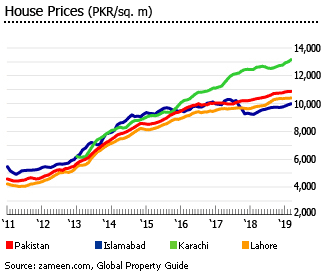
In 2016, the Federal Board of Revenue (FBR) introduced new valuation tables for the collection of capital gains tax and withholding tax at the federal level, with new rates higher than the DC rates - but still far below the market rates of properties. The difference between their valuations and actual market values are shown in the table below. Thus, despite strong activity, overall revenue collections from the property market remain low.
Average Valuation of 1 Kanal* of Residential Property/House, in PKR Thousands (As of Sept. 2018) |
|||||||||
| LAHORE | KARACHI | ISLAMABAD | |||||||
| DHA** Phase V | Cantt Area | WAPDA Town | DHA** Phase VI | North Karachi | Gulshane-Iqbal | D-12 | E-11 | G-11 | |
| District Collector (DC) rates | 14,000 | 14,000 | 8,800 | 6,987 | 1,197 | 6,987 | N/A | N/A | N/A |
| Federal Board of Revenue (FBR) rates | 8,400 | 11,700 | 8,400 | 15,124 | 3,024 | 15,124 | 19,541 | 15,730 | 23,050 |
| Market rates | 60,254 | 55,876 | 41,975 | 102,180 | 62,111 | 59,437 | 50,437 | 75,936 | 78,495 |
| * 1 Kanal is generally considered equal to 5,400 square feet **Defence Housing AuthoritySources: State Bank of Pakistan, Federal Board of Revenue | |||||||||
The low property valuations, coupled with weak regulatory oversight, also partly explain why speculative buying is rampant.
“Real estate is traded as a commodity in Pakistan; speculative investors buy property in bulk, and then sell it later at an exorbitant profit,” said Mohammad Shafi Jakvani of the Federation of Pakistan Chambers of Commerce and Industry (FPCCI) Standing Committee on Real Estate Research and Image Building.
Pakistan’s real estate market has evolved into a vital source of economic growth in the country. “The combined direct contribution of construction and housing sectors to the country’s GDP has been consistently higher than 9 percent over the past decade,” according to a report by the State Bank of Pakistan.
Estimates released by the FBR values the sector at about US$700 billion, according to an article released by Pakistan-based marketing and media magazine Aurora. The real estate sector not only generates high level of direct employment, it also stimulates demand in more than 250 ancillary sectors, such as cement, steel, brick, paint and other building materials.
Property market reforms
A number of reforms have been introduced in recent years to regulate the real estate market. Most of these measures aim to increase transparency and government tax revenues, as well as prevent speculative buying in the real estate market.
In 2009, for instance, filing of tax returns became compulsory for individuals owning an immovable property with land area greater than 500 square yards and/or flat with covered area of at least 2,000 square feet. Then in 2012, a Capital Gains Tax (CGT) on the sale of immovable property with holding period of less than two years was introduced.
The new government has acted to increase regulation. in 2018, the Finance Act of 2018 introduced vital measures to counter underdocumentation and to minimize the use of the property market to avoid tax obligations. More specifically, non-filers were barred from purchasing real property with value above PKR 5 million (US$ 35,243).
“Traditionally, the real estate sector has been used for parking of black money. To curtail this activity and to regulate the sector, the PTI-led government has initiated various policy options to control the further flow of illicit money in to the property market,” said Colliers International.
Major Government Reforms to Regulate the Real Estate Market |
||
| Year | Law | Measure |
| 2009 | Finance Act 2009 page 7 | Mandatory filing of returns by persons owning immovable property with land area greater than or equal to 500 square yards and/or having flat with covered area of 2,000 square feet or more |
| 2010 | FBR Circular No. C. No. ITP/B-2o1o-11/EC-e-Dox # 105236-R dated July 16, 2010 | Provinces were authorized to collect Capital Value Tax (CVT) on immovable property (located in province). |
| 2012 | Finance Act 2012 page 437, Division VIII of the amended Income Tax Ordinance 2001 | Introduction of a Capital Gains Tax (CGT) on sale of immovable properties, holding period of which is less than 2 years |
| 2014 | Finance Act 2014, page 135, Income Tax Ordinance 2001 amended up to June 2014, pages 328-329 | CGT charged at 10% for properties with holding period of up to 1 year, and 5% for those with holding period of up to 2 years. For properties with holding period of more than 2 years, no CGT would be charged. |
| 2014 | Finance Act 2014, page 146 and Income Tax Ordinance 2001 amended up to June 2014, pages 346 and 349 | Adjustable advance tax on sale of immovable properties at 0.5% for filers and 1% for non-filers of the gross amount. In case of purchase, the tax rate was 1% for filers and 2% for non-filers. Properties with values below PKR 3 million (US$21,145) are exempted from the advance tax. |
| 2016 | Income Tax Ordinance 2001 amended up to 31-8-2016, pages 364-365 | For immovable properties acquired on or after July 1, 2016, CGT was 10% if the holding period is up to 1 year; 7.5% if the holding period is greater than 1 year but less than 2 years; 5% if the holding period is greater than 2 year but less than 3 years. For those acquired before July 1, 2016, the CGT rate was 5% if the holding period is less than or equal to 3 years, and zero if the holding period exceeds 3 years. |
| 2016 | Finance Act 2016 and Income Tax Ordinance 2001 updated up to 31-8-2016, pages 388 and 390-391 | Advance tax on the purchase of immovable property with value of greater than PKR 4 million (US$28,195) was raised to 2% for filers and 4% for non-filers. In case of sale, the tax rate was 1% of the gross amount of the consideration received for filers and 2% for non-filers. |
| 2016 | Federal Board of Revenue valuation tables | Effective July 31, 2016, new valuation rates are used for the calculation of federal taxes such as CGT and advance tax on sale and purchase of immovable property in 20 major cities |
| 2018 | Foreign Assets (Declaration and Repatriation) Act 2018 and Voluntary Declaration of Domestic Assets Act 2018 | An amnesty scheme for declaration of undisclosed assets was introduced until June 2018 |
| 2018 | Finance Act 2018, Sec 227C page 82 and Income Tax Ordinance 2001 amended up to Oct 30, 2018, page 342 | Non-filers were barred from purchasing real property with value above PKR 5 million (US$ 35,243) |
| Sources: State Bank of Pakistan, Federal Board of Revenue | ||
Acute shortage of affordable housing
Pakistan’s housing deficit is estimated at around 10 million units, which means that more than a third of the 32 million households in the country are not provided with adequate housing, according to the SBP. Worse, the housing backlog is increasing by 200,000 units every year, based on estimates.
There are multiple reasons for Pakistan’s housing woes. These include: non-availability of a common record of land and entitlement; stringent regulations for site development; limited financing has priced out lower-to-middle income segments; and reluctance of banks to expand their mortgage portfolio due to weak contract enforcement and uncertainty of title deeds.
According to the SBP, the affordable house price to income ratio in Pakistan is 20:1, far worse than the global average of 5:1. As a result, more than half of the country’s urban population lives in slums and squatter settlements (katchi abadis).
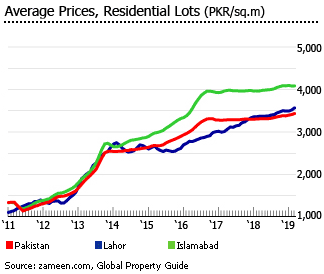
In an effort to address the housing crisis, PM Khan launched in October 2018 the ambitious Naya Pakistan Housing Programme (NPHP) project, an affordable housing scheme for low-income households. Under this program, at least five million low-cost houses will be built nationwide.
Then in January 2019, the federal government announced a 19% income tax rebate on the revenue generated from loans given for low-income housing, small businesses, and agricultural projects. It also proposed the establishment of an interest-free revolving credit (Qarz-e-Husna) worth PKR 5 billion (US$35.24 million) to fund the construction of affordable houses.
Morever, Prime Minister Imran Khan recently called for the construction of high-rise (vertical) buildings across the country, instead of detached houses and villas, amidst the continued rise in land prices. Land values increased 2.6 times from 2011 to 2018.
Demand for high-rise apartments is rapidly growing
Apartment living is rapidly becoming popular in Pakistan, as cities become increasingly congested and land prices continue to surge, according to an article released by Pakistan-based marketing and media magazine Aurora.
In the past five years, the demand for apartments increased by nearly 30%, fuelling the surge in the number of newly constructed high-rise luxury apartments in Karachi, Lahore and Islamabad.
Karachi’s posh neighborhoods, such as Nazimabad, Federal B. Area, PECHS, Clifton, and several phases of DHA, are gradually shifting to luxury condominiums and apartments from the traditional lavish mansions. Likewise in Lahore, fully serviced apartment projects are sprawling in the city outskirts such as in the Raiwind and Multan Roads and in residential hotspots such as Gulberg and the Canal Road. In Islamabad, an increasing number of apartment projects can be seen in Jinnah Avenue, Bahria Enclave and around the new Islamabad Airport, among others.
“Since the metropolitan trio comprising Karachi, Lahore and Islamabad is reaching saturation levels in terms of land availability for new projects, an increasing number of builders and developers have shifted their focus on creating vertical urban clusters in the city centres, and sprawling gated communities at the outskirts,” said Akhlaq Ahmed of Manhill Advertising.
Some of the most popular luxury condominium developments that were introduced recently include: Creek Vista Apartments (Phase VIII, DHA, Karachi), Saima Presidency (Malir Cantonment, Karachi), Al-Khaleej Towers (Federal B. Area, Karachi), Springs Apartment Homes (Canal Bank, Lahore), and Veranda Residence (Sector E-11, Islamabad). Most of these condos have a covered area between 2,400 and 3,000 square feet, with prices ranging from PKR 38 million (US$267,850) to PKR 65 million (US$458,160).
Mortgage market is almost nonexistent
Despite rapid growth in recent years, Pakistan’s mortgage market remains very small. In 2018, its size was equivalent to just about 0.3% of GDP in 2018, based on Global Property Guide estimates. Reasons? Very high interest rates and limited mortgage offerings.
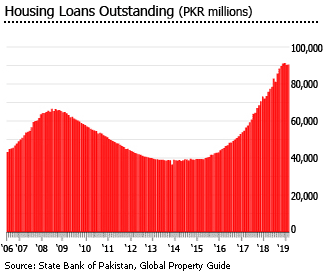
Currently, mortgage rates range from 15% to 18% - the lowest level in a decade but still very high when compared to international standards.
“Home mortgages, the principle on which the global real estate industry operates, is a non-existent concept in Pakistan; home financing offered by commercial banks is largely limited to high-net income earners, and the House Building Finance Corporation hardly gives out loans anymore,” said Akhlaq Ahmed of Manhill Advertising.
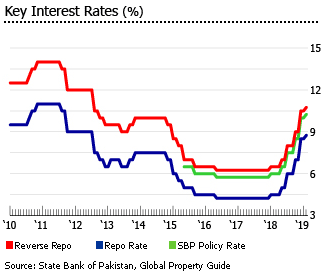
As of February 2019, the total amount of housing loans outstanding stood at PKR 90.41 billion (US$637.3 million), up 23.2% from the same period last year, according to the State Bank of Pakistan (SBP), the country’s central bank. Housing loans grew by an average of 29% annually from 2016 to 2018.
Recently, the SBP has established a dedicated Infrastructure and Housing Finance Department to strengthen market-based housing finance in the country.
Slowing economic growth; high inflation
The economy grew by a robust 5.2% in 2018, after expansions of 5.4% in 2017, 4.6% in 2016, and 4.1% in both 2014 and 2015, according to the State Bank of Pakistan.
However, economic growth is projected to slow around 3.9% during the FY2019, according to the Asian Development Bank (ADB), amidst large budget deficits and external account imbalances.
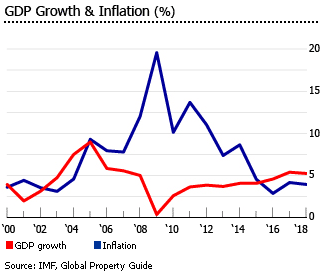
“Real GDP growth during FY19 is likely to moderate significantly, mainly due to slowdown in the growth of the agriculture sector and stabilization measures taken to preserve macroeconomic stability,” the central bank said.
High inflation is also a concern. In March 2019, Pakistan’s inflation stood at 9.4%, up from 8.2% in the previous month and 3.2% in the same period last year, according to the Pakistan Bureau of Statistics (PBS), amidst rising energy prices and the depreciation of the domestic currency. In fact, it was the highest level recorded since November 2013.
Inflation is expected to be about 6.5% to 7.5% this year, according to the central bank.
“Until macroeconomic imbalances are alleviated, the outlook is for slower growth, higher inflation, pressure on the currency, and heavy external financing needed to maintain even a minimal cushion of foreign exchange reserves,” said the ADB. “Recurrent crises in the balance of payments require that firms become more export competitive.”
real estate pakistan, real estate, real estate in pakistan, real estate karachi, pakistan real estate, terrorist houses, bomb the usa, kill all foreigners, builders in karachi, bukhari commercial, chohan estate, property dealer, real estate in karachi, bahria town karachi, badar commercial, karachi real estate, real estate companies in, vladimir putin, overpopulation in india, india overpopulation, is google a monopoly, us marines, we have met the enemy and he is us, howdy modi, petrodollar, holocaust museum, international policy digest, imperialism in the middle east, henry jackson society, bbc sex, pakistan failed state, new space race, why should we help the homeless, sex for grades, dmitry rybolovlev, iran before 1979, man on the moon, china cybersecurity law, population problem in india, teresa shook, anies baswedan, a380 size, america is an idea, beef ban, problems in south america, populism in latin america, social change issues, farhad azima, corporatism vs capitalism, moorfield storey institute, vladmir putin, ethiopian civil war, erdogan ottoman empire, is google a monopoly?, james.dorsey, stree, beef ban in india, colin powell trump, holocaust museum washington dc, monsanto roundup controversy, women´s rights in iran before 1979, moroccan people, capitalism vs corporatism, imperialism in middle east, left wing vs right wing, senkaku islands dispute, roundup controversy, bitcon, classless societies, issues in south america, yasser arafat, why help the homeless, middle east imperialism, india population problems, what is the belt and road initiative, black 47, leftist youtubers, policies that need to be changed, manikarnika review, documentary about sex, middle eastern imperialism, ethiopian civil wars, orphans in pakistan, social change issue, alec ross, indonesia women rights, overpopulation india, sex in woods, beef in india, silk road initiative, sue bob white, denmark carbon tax, rivers of the middle east, should we help the homeless, right wing youtubers, wakanda africa, horn of africa piracy, iran before and after, el chapo narcos mexico, india beef ban, left wing youtube channels, somali government, relationship between education and politics, american feminism, democrats and farrakhan, population problems in india, saudi government, senkaku island dispute, why feminism is bad, leftist youtube channels, racism in malaysia, make russia great again, una mujer fantástica, iran after 1979, america feminism, israel wall, horses for, pogo we have met the enemy, the regressive left, manikarnika, modern city, legion, tpp debate, zelyonka, saudi arabia royal family, why feminism is wrong, china neocolonialism, afghanistan russia, river in the middle east, imperialism middle east, japanese feminism, everything trump touches dies, tuco ramirez, social policies that need to be changed, tudeh party, domestic affairs, social policy issues, walls in israel, james durso, swedish model, what are domestic affairs, india beef, farrakhan democrats, natasha ezrow, problems with feminism, rivers in middle east, crime in the media, media and crime, marriage dowries in india reflect, where was malthus right, pogo we have met the enemy and he is us, peninsula shield force, changes in education, morocco people, biggest liar, india syria, lebanese christians, water pods, washington dc holocaust museum, sand war, we have met the enemy and they are ours, trust busting, problems of overpopulation in india, how many blue collar workers in america, foreign language in america, farrakhan democrat, jimmie åkesson, india´s population problem, iran pre revolution, new york city open data, monuments men book, sweden submarines, tudehparty, czech republic russia, daniel wagner, untermenschen, right wing youtube channels, munr kazmir, gully boy review, access any websites, over population in india, bill clinton kosovo, mexico female, is egypt in the middle east, why we should help the homeless, how many blue collar workers are there in america, we are columbine, marital rape india, anti trumpers, legion tv show, new scramble for africa, trump drain the swamp, otto skorzeny’s organization spider, de radicalization, salman al ansari, social polarization, black earth rising, russia and the west, beef ban india, pakistan is a failed state, pre revolution iran, christians in lebanon, gold mine in south america, why the right is dominating youtube, rybolovlev, china cyber security, russia in afghanistan, media influence on crime perception, iran before and after revolution, trump ideology, philippines and america, america idea, food as a weapon, ek ladki ko dekha toh aisa laga, population issue in india, james dorsey, quran homosexualitypakistan, hanif machiyara, khayaban e badar, builders and developers in karachi, dha phase 8 karachi map, salahuddin tunio, real estates, real estate agents in islamabad, masha allah, universal property network, karachi map, shahid rasheed butt, khayaban e sehar, real state, house for sale in karachi, property websites in pakistan, real estate websites in pakistan, property for sale in karachi, badar commercial map, real estate agent, shaheen agent, top real estate companies in pakistan, session court jhelum, shahbaz commercial, eproperty, tauheed commercial, dha phase 8 map, true value properties, pakistan directory, dha phase 6 karachi map, commercial area, al murtaza, tabbani, lahore real estate, realstate, khayaban e tanzeem, syed zada, advice associates, estate agents in karachi, citi associates, estate, zamzama, sehar enterprises, dha phase 8 karachi, dha phase 2 karachi, phase 6 dha karachi, akbar associates, pak multi services, map of karachi, tabani real estate, gizri karachi map, estate agency, dha phase 2 extension karachi map, property dealers in lahore, khayaban e badban, dha phase 7 karachi, hassan cheema, estate agents, badar commercial phase 5 google map, dha phase 8 map karachi, javed khanani, maps karachi, ali associates, zam zama karachi, khayaban e bukhari, khayaban e ittehad, ali block bahria town karachi, property advisor, linkers realty, takaful estate, dha phase 2 karachi map, map karachi, athar associates, ali town karachi, badar commercial karachi, property dealers in islamabad, property listing, islamabad real estate, dha phase 6 map karachi, dha phase 1 karachi, property house, real estate companies, dha head office karachi, property dealer in lahore, karachi map download, zamzama karachi, dha phase 6 karachi, house for rent in faisalabad, dha phase 5 karachi, real estate business in pakistan, 10th, lahore estate, khada market, dha karachi, bahria town ali block, karachi property, haneef qureshi, al rehman developers, ali block, dha today, al ghafoor, murtaza mughal, pakistan property, phase 5, karachi maps, malik abid, schon circle, real estate islamabad, property karachi, ik associates, sammar and sammar, real estate agents, baitul mukarram masjid gulshan iqbal, dha phase 2 extension, faisal associates, anees hussain dha, karachi dha, aviation enclave, aaa associates, defclarea, dha medical centre karachi, khayaban e rahat, ali town, qaiser abbas, dha karachi map, ujala pakistan, property in karachi, shahzad memon, mian brothers, khayaban e shahbaz, rafi and sons, aziz builders, dha karachi map phase 6, baba jee, kashif bhatti, butt and bhatti, dha marina club, ali saqlain real estate, rana sajid hussain, fatima jinnah colony karachi, fari madoos, yd pak, darbar mahal, sunset in karachi, ali block bahria town, ma sha allah, lahore real estate ads, real estate company, al khidmat, property dealers in karachi, property pakistan, gulshan e maymar, dha medical centre, karachi mao, defence phase 2, dha, c pak map, gulshan e hadeed, dha map karachi, dha phase 6, axact karachi, property dealer in islamabad, phase 8 map, paras karachi, manzoor colony, zameer khan zameer, zarghoon housing scheme, abdullah enterprises, malik asim, sahil, malik atta, pak investor guide, phase 6, defence phase 2 karachi google map, nisar shaheed park karachi, saima mall karachi, ali saqlain, area 51 karachi, house for rent in bahawalpur, aa enterprises, abdullah builders, property in pakistan, malik qaiser awan, bashrat, sardar naseem, askari 6 peshawar, true value
Sources:
- Pakistan House Price Index (March 2019) (Zameen.com): https://www.zameen.com/index/buy/houses/
- World Economic Outlook Database (International Monetary Fund): https://www.imf.org/external/pubs/ft/weo/2019/01/weodata/index.aspx
- Pakistan Real Estate Market Review – 2018 (Colliers International): http://www.colliers.com/-/media/files/marketresearch/apac/pakistan/pakistanrem2018.pdf
- Pakistan Real Estate Market (Colliers International): http://www.colliers.com/-/media/files/marketresearch/apac/pakistan/col_whitepapers_16112018_vedit06122018_finalv2.pdf
- Economic Data (State Bank of Pakistan): http://www.sbp.org.pk/ecodata/index2.asp
- Special Section 1: Real Estate – Implementing the Announced Reforms (State Bank of Pakistan): https://www.sbp.org.pk/reports/quarterly/fy19/First/Special-Section-1.pdf
- How do we solve the housing crisis in Pakistan? (The Nation): https://nation.com.pk/18-Mar-2019/how-do-we-solve-the-housing-crisis-in-pakistan
- Pakistan’s real estate divide (Aurora): https://aurora.dawn.com/news/1141727
- Real estate market unfazed by economic shocks (The Express Tribune): https://tribune.com.pk/story/1862319/2-real-estate-market-unfazed-economic-shocks/
- Why the time’s right to invest in Pakistan property (Khaleej Times): https://www.khaleejtimes.com/business/real-estate/why-the-times-right-to/-invest-in-pakistan-property
- Pakistan’s property market awaits chance for an upturn (Gulf News): https://gulfnews.com/business/property/pakistans-property-market-awaits-chance-for-an-upturn-1.2278381
- Pakistan central bank sees 2019 GDP growth slowing to 3.5-4.0 percent (Reuters): https://in.reuters.com/article/pakistan-economy/pakistan-central-bank-sees-2019-gdp-growth-slowing-to-35-40-percent-idINKCN1R61JE
- Pakistan’s GDP growth to hover around 5 percent in 2019: GECS (The News): https://www.thenews.com.pk/print/458836-pakistan-s-gdp-growth-to-hover-around-5-percent-in-2019-gecs
- Pakistan’s GDP to decelerate to 3.9% in 2019: Asian Development Bank (Business Today): https://www.businesstoday.in/top-story/pakistan-gdp-to-decelerate-to-39-in-2019-asian-development-bank/story/333861.html
- Inflation on the rise (The News): https://www.thenews.com.pk/print/452691-inflation-on-the-rise
- Pakistani rupee plunges about 6 percent in what traders say could be a central bank devaluation (CNBC): https://www.cnbc.com/2018/11/30/pakistani-rupee-plunges-in-likely-central-bank-devaluation-traders.html
- Pakistan profile – Timeline (BBC News): https://www.bbc.com/news/world-south-asia-12966786